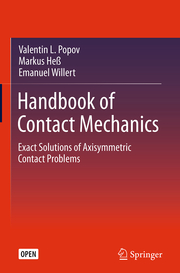Detailansicht
Handbook of Contact Mechanics
Exact Solutions of Axisymmetric Contact Problems
ISBN/EAN: 9783662587089
Umbreit-Nr.: 6086153
Sprache:
Englisch
Umfang: xvi, 347 S., 210 s/w Illustr., 19 farbige Illustr.
Format in cm:
Einband:
gebundenes Buch
Erschienen am 08.05.2019
Auflage: 1/2019
- Zusatztext
- This open access book contains a structured collection of the complete solutions of all essential axisymmetric contact problems. Based on a systematic distinction regarding the type of contact, the regime of friction and the contact geometry, a multitude of technically relevant contact problems from mechanical engineering, the automotive industry and medical engineering are discussed. In addition to contact problems between isotropic elastic and viscoelastic media, contact problems between transversal-isotropic elastic materials and functionally graded materials are addressed, too. The optimization of the latter is a focus of current research especially in the fields of actuator technology and biomechanics. The book takes into account adhesive effects which allow access to contact-mechanical questions about micro- and nano-electromechanical systems.Solutions of the contact problems include both the relationships between the macroscopic force, displacement and contact length, as well as the stress and displacement fields at the surface and, if appropriate, within the half-space medium. Solutions are always obtained with the simplest available method - usually with the method of dimensionality reduction (MDR) or approaches which use the solution of the non-adhesive normal contact problem to solve the respective contact problem.
- Kurztext
- This open access book contains a structured collection of complete solutions of all significant axially symmetric contact problems. It provides solutions for classical profiles such as the sphere, cone or flat cylindrical punch as well as a multitude of other technically relevant shapes, e.g. the truncated cone, the worn sphere, rough profiles, hollow cylinders, etc. Normal, tangential and torsional contacts with and without adhesion are examined. Elastically isotropic, transversally isotropic, viscoelastic and functionally graded media are addressed. The solutions of the contact problems cover the relationships between the macroscopic quantities of force and displacement, the contact configuration as well as the stress and displacement fields at the surface and in some cases within the half-space medium. The solutions are obtained by the simplest available method - usually involving the method of dimensionality reduction or approaches of reduction to the non-adhesive normal contact problem. The target audiencesThis book is geared towards engineers working in e.g. mechanical engineering, the tire industry, the automotive industry, polymer- and elastomer manufacturing. Additionally, it functions as a reference work for research and teaching.Prof. Dr. rer. nat. Valentin L. Popov studied physics and obtained his doctorate in 1985 from the Lomonosov Moscow State University. He habilitated 1994 at the Institute of Strength Physics and Materials Science of the Russian Academy of Sciences. Since 2002 he has headed the Chair of System Dynamics and Friction Physics in the Institute of Mechanics at TU Berlin. Dr. Markus Heß studied Engineering Science at TU Berlin. He obtained his doctorate in 2011 and in the same year received the research award of the German Tribology Society for his dissertation. From 2011 to 2015 he headed the physics department of the preparatory college of TU Berlin and since 2015 has been working as an assistant professor at the Chair of System Dynamics and Friction Physics.M.Sc. Emanuel Willert studied Engineering Science at TU Berlin and the Tomsk Polytech-nic University. Since 2015 he has been working as a research assistant at the Chair of System Dynamics and Friction Physics.
- Autorenportrait
- Valentin L. Popov, full professor at the Berlin University of Technology, studied physics (1976-1982) and obtained his doctorate in 1985 from the Moscow State Lomonosov University. He worked at the Institute of Strength Physics of the Russian Academy of Sciences. After a guest-professorship in the field of theoretical physics at the University of Paderborn (Germany) from 1999 to 2002, he has headed the department of System Dynamics and the Physics of Friction in the Institute of Mechanics at the Berlin University of Technology. His areas of interest include tribology, nanotribology, tribology at low temperatures, biotribology, the influence of friction through ultrasound, numerical simulation of frictional processes, research regarding earthquakes, as well as themes relating to materials sciences such as the mechanics of elastoplastic media with microstructures, strength of metals and alloys, and shape memory alloys. He has published 30 papers in leading international journals during the past 5 years. He is the author of the book "Contact Mechanics and Friction: Physical principles and applications" which appeared in German, English, Chinese, and Russian editions. He is the joint editor of international journals and regularly organizes international conferences and workshops over diverse tribological themes. He is a member of the Scientific Council of the German Tribological Society. He has intensively collaborated with many industrial corporations and possesses experience in implementing the results of scientific research in industrial applications.Dr. Markus Heß, studied physical engineering sciences at the Berlin University of Technology. He obtained his doctorate in 2011, receiving in the same year the Research Prize from the German Tribological Society for his dissertation. From 2011 to 2015 he headed the department of physics at the Studienkolleg of the Berlin University of Technology and taught engineering mathematics and physics. Since 2015, he has been a research associate and lecturer at the department of System Dynamics and the Physics of Friction in the Institute of Mechanics at the Berlin University of Technology. He is the co-author of the book "Method of Dimensionality Reduction in Contact Mechanics and Friction" which appeared in German and English editions.M. Sc. Emanuel Willert, studied physical engineering sciences at the Berlin University of Technology and the Polytechnic University of Tomsk. Since 2015, he has been a teaching and research assistant at the department of System Dynamics and the Physics of Friction in the Institute of Mechanics at the Berlin University of Technology
